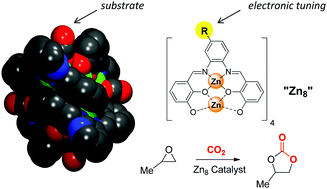The synthesis and characterization of nonsymmetrical octanuclear Schiff base clusters derived from nonsymmetrical diamine precursors is reported. These cluster complexes, typically assemblies comprising of four bimetallic salphen units, are isolated as a mixture of geometrical isomers as a result of different relative positions of the peripheral groups present in the diamine connectors within each cluster compound. A variety of peripheral groups can be installed including aryl bromides, protected carboxylic acids and pyridyl functionalities. The analysis of these octanuclear systems has been challenging, though mass spectrometric analysis provides a useful and diagnostic tool for the straightforward determination of the mono-disperse nature of these products. The presence of various electron-withdrawing and -donating groups on the peripheral aryl fragment allows for electronic modulation as supported by the application of these cluster derivatives in the homogeneous catalytic conversion of epoxides into their respective cyclic carbonates.
